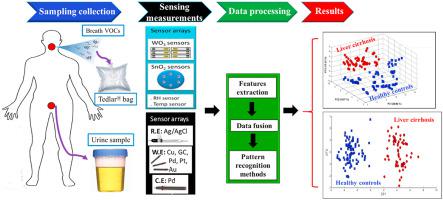Analytica Chimica Acta ( IF 6.2 ) Pub Date : 2021-09-03 , DOI: 10.1016/j.aca.2021.339028 Omar Zaim 1 , Alassane Diouf 1 , Nezha El Bari 2 , Naoual Lagdali 3 , Imane Benelbarhdadi 3 , Fatima Zohra Ajana 3 , Eduard Llobet 4 , Benachir Bouchikhi 5

|
Advanced stage detection of liver cirrhosis (LCi) would lead to high mortality rates in patients. Therefore, accurate and non-invasive tools for its early detection are highly needed using human emanations that may reflect this disease. Human breath, along with urine and blood, has long been one of the three main biological media for assessing human health and environmental exposure. The primary objective of this study was to explore the potential of using volatile organic compounds (VOCs) assay of exhaled breath and urine samples for the diagnosis of patients with LCi and healthy controls (HC). For this purpose, we used a hybrid electronic nose (E-nose) combining two sensor families, consisting of an array of five commercial chemical gas sensors and six interdigitated chemical gas sensors based on pristine or metal-doped WO3 nanowires for sensing volatile gases in exhaled breath. A voltammetric electronic tongue (VE-tongue), composed of five working electrodes, was dedicated to the analysis of urinary VOCs using cyclic voltammetry as a measurement technique. 54 patients were recruited for this study, comprising 22 patients with LCi, and 32 HC. The two-sensing systems coupled with pattern recognition methods, namely Principal Component Analysis (PCA) and Discriminant Function Analysis (DFA), were trained to classify data clusters associated with the health status of the two groups. The diagnostic performances of the E-nose and VE-tongue systems were studied by using the receiver operating characteristic (ROC) method. The use of the E-nose or the VE-tongue separately, trained with these appropriate classifiers, showed a slight overlap indicating no clear discrimination between LCi patients and HC. To improve the performance of both electronic sensing devices, an emerging strategy, namely a multi-sensor data fusion technique, was proposed as a second aim to overcome this shortcoming. The data fusion approach of the two systems, at a medium level of abstraction, has demonstrated the ability to assess human health and disease status using non-invasive screening tools based on exhaled breath and urinary VOC analysis. This suggests that exhaled breath as well as urinary VOCs are specific to a disease state and could potentially be used as diagnostic methods.
中文翻译:

电子鼻和伏安电子舌法比较分析呼气和尿液挥发性有机物区分肝硬化患者与健康对照组
肝硬化 (LCi) 的晚期检测将导致患者的高死亡率。因此,非常需要使用可能反映这种疾病的人类放射物进行早期检测的准确和非侵入性工具。长期以来,人类呼吸以及尿液和血液一直是评估人类健康和环境暴露的三种主要生物介质之一。本研究的主要目的是探索使用呼出气和尿液样本的挥发性有机化合物 (VOC) 测定法诊断 LCI 患者和健康对照 (HC) 的潜力。为此,我们使用了混合电子鼻 (E-nose),结合了两个传感器系列,由五个商用化学气体传感器和六个基于原始或金属掺杂 WO 的交叉化学气体传感器组成。3用于感应呼出气中挥发性气体的纳米线。由五个工作电极组成的伏安电子舌 (VE-tongue) 专门用于使用循环伏安法作为测量技术分析尿液 VOC。本研究招募了 54 名患者,包括 22 名 LCI 患者和 32 名 HC。结合模式识别方法的双传感系统,即主成分分析(PCA)和判别函数分析(DFA),被训练来对与两组健康状况相关的数据簇进行分类。使用接收器操作特征(ROC)方法研究了电子鼻和 VE 舌系统的诊断性能。分别使用 E-nose 或 VE-tongue,用这些适当的分类器训练,显示出轻微的重叠,表明 LCI 患者和 HC 之间没有明显的区别。为了提高两种电子传感设备的性能,提出了一种新兴策略,即多传感器数据融合技术,作为克服这一缺点的第二个目标。这两个系统的数据融合方法在中等抽象水平上已经证明了使用基于呼出气和尿液 VOC 分析的非侵入性筛查工具评估人类健康和疾病状态的能力。这表明呼出气和尿中 VOC 是特定于疾病状态的,并且有可能用作诊断方法。被提议作为克服这一缺点的第二个目标。这两个系统的数据融合方法在中等抽象水平上已经证明了使用基于呼出气和尿液 VOC 分析的非侵入性筛查工具评估人类健康和疾病状态的能力。这表明呼出气和尿中 VOC 是特定于疾病状态的,并且有可能用作诊断方法。被提议作为克服这一缺点的第二个目标。这两个系统的数据融合方法在中等抽象水平上已经证明了使用基于呼出气和尿液 VOC 分析的非侵入性筛查工具评估人类健康和疾病状态的能力。这表明呼出气和尿中 VOC 是特定于疾病状态的,并且有可能用作诊断方法。



























 京公网安备 11010802027423号
京公网安备 11010802027423号